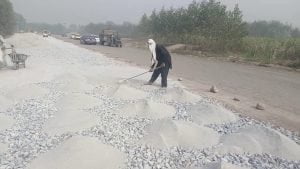Table of Contents
There are different stages of road development. Among them, Macadam Road is the most successful type.
John Loudon Macadam (1756 -1836 AD) was the surveyor-general of the road in England who put forward an entirely new method of road construction called the macadam road. This road was the first road based on scientific thinking.
The importance of subgrade, drainage, and compaction was also recognized. So the subgrade was compacted and was prepared with a slope of (1 in 36 ).

a. How Macadam Road was constructed?
~ The standard size of the road was taken as 4.5 m.
~ The total thickness of the base, sub-base, and surface course was taken as 25 cm.
~ The construction of the macadam road consists of the following steps:
a. Sub Grade Preparation
Compacted subgrade having cross-slope 1 in 36 was prepared.
b. Sub Base Preparation
It was the layer above subgrade that was constructed using stones passing through a 5 cm sieve.
Its thickness was 10cm.
c. Base Course Preparation
The base course was prepared from broken stones passing through a 3.75 cm sieve.
Its thickness was 10 cm.
d. Surface Course Preparation
It was prepared using broken stones passing through a 1.9 cm sieve.
Its thickness was 5 cm.
Note:
It is the process of road construction when it was introduced by John Macadam.
| Read More: Low-Cost Road, Types of low-cost road, Construction of Low-cost road |
b. What are the types of Macadam Road?
Over time, different modified macadam roads were developed.
Using binding materials in macadam roads has become more popular because of the increased durability and life of the road.
Macadam road can be classified into the following four types.
a. Water Bound Macadam
Over time, different road building technology was applied to macadam road by several engineers. One of them was Richard Edgeworth.
He filled the gaps between the surface stones using a mixture of stone dust and water to make the surface more smooth. This method of construction is named water-bound macadam.

The macadam road whose wearing coarse is constructed with clean crushed aggregates which are mechanically interlocked by rolling and bounded together with the mixture of filler material(sand or clay) and water that is laid on a prepared base course.
Water Bound Macadam Road is abbreviated as WBM road.
Advantages
a. Made from local materials and labor.
b. It is economical to construct.
c. No skilled manpower is required.
Disadvantages
a. They are permeable.
b. Short life.
c. Production of dust during service.
| Also Read: Construction, advantages & disadvantages of Water Bound Macadam Road. |
b. Traffic Bound Macadam
In this macadam, broken stones or gravels are generally used at a wearing course. Multi-layers of stones and gravels are provided in this type.
It is used in rural as well as urban areas.
The compacted thickness of each layer may vary from 2.5 to 5.0 cm.
c. Bituminous Macadam
In bituminous macadam, bitumen is used as a binding material to bind stone chips and also to bind base and sub-base courses.
It is also called Tar Bound Macadam.
The dust becomes a serious problem on macadam roads; so bituminous macadam was introduced.
Flexible pavement is a modified type of Bituminous Macadam.
d. Cement Macadam
Cement macadam is quite similar to bitumen macadam. Cement is used as a binding material instead of bitumen.
Rigid Pavement is a modified type of Cement Macadam.
| Read More: Earth Road, Types of Earth Road, Construction of Earth Road |

